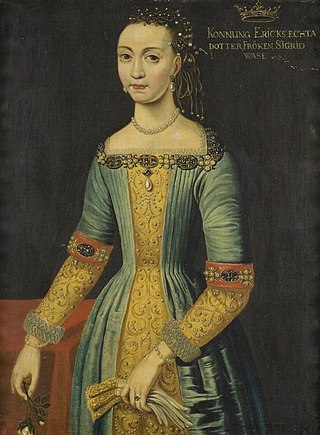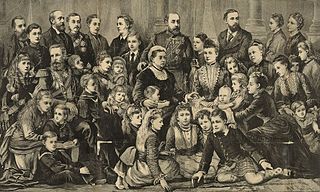Princess Anne (born 1950) is the daughter of Queen Elizabeth II and Prince Philip, Duke of Edinburgh.
Contents
Princess Anne may also refer to:
Princess Anne (born 1950) is the daughter of Queen Elizabeth II and Prince Philip, Duke of Edinburgh.
Princess Anne may also refer to:

Sophia was Electress of Hanover from 19 December 1692 until 23 January 1698 as the consort of Prince Elector Ernest Augustus. She was later the heiress presumptive to the thrones of England and Scotland and Ireland under the Act of Settlement 1701, as a granddaughter of King James VI and I. Sophia died less than two months before she would have become Queen of Great Britain and Ireland. Consequently, her son George I succeeded her first cousin once removed, Queen Anne, to the British throne, and the succession to the throne has since been defined as, and composed entirely of, her legitimate and Protestant descendants.

Princess Royal is a style customarily awarded by British monarchs to their eldest daughters. Although purely honorary, it is the highest honour that may be given to a female member of the royal family. There have been seven Princesses Royal. Princess Anne became Princess Royal in 1987.
An heir presumptive is the person entitled to inherit a throne, peerage, or other hereditary honour, but whose position can be displaced by the birth of a person with a better claim to the position in question. This is in contrast to heirs apparent, whose claim on the position cannot be displaced in this manner.

Prince George of Denmark and Norway was the husband of Anne, Queen of Great Britain. He was the consort of the British monarch from Anne's accession on 8 March 1702 until his death in 1708.

The Mountbatten family is a British dynasty that originated as a British branch of the German princely Battenberg family. The name was adopted on 14 July 1917, three days before the British royal family changed its name from "Saxe-Coburg and Gotha" to "Windsor", by members of the Battenberg family residing in the United Kingdom, due to rising anti-German sentiment among the British public during World War I. The name is a direct Anglicisation of the German Battenberg, or Batten mountain, the name of a small town in Hesse. The titles of count and later prince of Battenberg had been granted in the mid-19th century to a morganatic branch of the House of Hesse-Darmstadt, itself a cadet branch of the House of Hesse.

The use of the title of Princess of the United Kingdom of Great Britain and Northern Ireland is entirely at the will of the sovereign as expressed in letters patent. Individuals holding the title of princess are styled "Her Royal Highness" (HRH). On 18 April 1917, Frederica of Hanover, the newest granddaughter of Wilhelm II, German Emperor was styled a British princess from birth, even though Germany and Britain were fighting in World War I. Before the First World War, British princesses also held additional German titles, such as princesses of Hanover by virtue of being male-line descendants of George III; or princesses of Saxe-Coburg and Gotha, duchess of Saxony, by virtue of being male-line descendants of Prince Albert of Saxe-Coburg and Gotha. George V issued letters patent on 30 November 1917, to restrict the automatic assignment of the title "princess" and the use of the style "Royal Highness" to the following persons:

Princess is a title used by a female member of a monarch's family or by a female ruler. The male equivalent is a prince. Most often, the term has been used for the consort of a prince, or for the daughter of a monarch. A crown princess can be the heir apparent to the throne or the heir apparent's spouse.
Princess Mary may refer to:

Duchess Marie Elisabeth of Saxony was a duchess consort of Holstein-Gottorp as the spouse of Duke Frederick III of Holstein-Gottorp. As a widow, she became known as a patron of culture.
Louise or Luise may refer to:
Princess Margaret (1930–2002) was the daughter of King George VI of the United Kingdom and Elizabeth Bowes-Lyon; sister of Queen Elizabeth II of the United Kingdom.

Queen Victoria, the British monarch from 1837 to 1901, and Prince Albert had 9 children, 42 grandchildren, and 87 great-grandchildren. Victoria was called the "grandmother of Europe".
Honouring individuals buried in Westminster Abbey has a long tradition.
Anne Stuart may refer to:

St George's Chapel at Windsor Castle in England is a castle chapel built in the late-medieval Perpendicular Gothic style. It is a Royal Peculiar, and the Chapel of the Order of the Garter. St George's Chapel was founded in the 14th century by King Edward III and extensively enlarged in the late 15th century. It is located in the Lower Ward of the castle.
Since William the Conqueror claimed the English throne, succession has been determined by bequest, battle, primogeniture, and parliament.

Margaret Stuart was the second daughter of King James VI of Scotland and Anne of Denmark. Sometime in March 1600, Margaret died of an unknown illness and she was buried in Holyrood Abbey. Three years later, her father ascended the throne of England.
Margaret of Denmark may refer to: